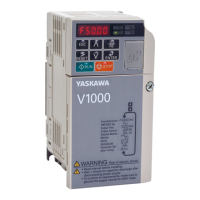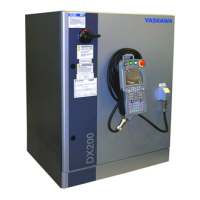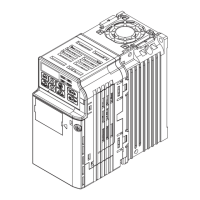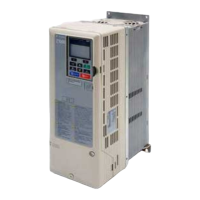6.9 Troubleshooting without Fault Display
278 YASKAWA ELECTRIC SIEP C710606 44B YASKAWA AC Drive T1000V Technical Manual
■ Buzzing Sound from Motor at 2 kHz
■ Unstable Motor Speed when Using PM or IPM
■ Motor Does Not Operate When the RUN Button on the Digital Operator is Pressed
■ Motor Does Not Operate When an External Run Command is Input
■ Motor Stops During Acceleration or When a Load is Connected
■ Motor Rotates in One Direction Only
Cause Possible Solutions
Exceeded 110% of the rated output current of the
drive while operating at low speeds.
• If the output current rises too high at low speeds, the carrier frequency automatically
reduces and causes a whining or buzzing sound.
• If the sound is coming from the motor, disable carrier frequency derating (L8-38 = “0”).
• Disabling the automatic carrier frequency derating increases the chances of an overload
fault (oL2). Switch to a larger capacity motor if oL2 faults occur too frequently.
Cause Possible Solutions
The motor code for PM (E5-01) is set incorrectly.
(Yaskawa motors only)
Set parameter E5-01 in accordance with the motor being used.
The drive is operating at less than 10% of the speed
reference.
Consult with Yaskawa about using a different type of motor when attempting to operate at
10% of the speed reference.
Motor hunting occurs.
Set and carefully adjust the following parameters in the order listed:
• n8-45 (Speed Feedback Detection Suppression Gain)
• n8-55 (Load Inertia for PM Motors)
• C4-02 (Torque Compensation Primary Delay Time)
Hunting occurs at start. Increase the S-curve time at the start of acceleration (C2-01).
Too much current is flowing through the drive.
• If using a PM motor, set the correct motor code to E5-01.
• If using a specialized motor, set parameter E5- to the correct value according to the
Motor Test Report.
Cause Possible Solutions
The LOCAL/REMOTE mode is not selected
properly.
Press the LOCAL/REMOTE button to switch. The LO/RE LED should be on for LOCAL
mode.
The drive is not in drive mode. A run command will not be issued. Exit to the drive mode and cycle the run command.
The frequency reference is too low.
• If the frequency reference is set below the frequency set in E1-09 (Minimum Output
Frequency), the drive will not operate.
• Raise the frequency reference to at least the minimum output frequency.
Cause Possible Solutions
The LOCAL/REMOTE mode is not selected
properly.
Press the LOCAL/REMOTE button to switch. The LO/RE LED should be off for REMOTE
mode.
The drive is not in Drive Mode. A run command will not be issued. Exit to the Drive mode and cycle the run command.
The frequency reference is too low.
• If the frequency reference is set below the frequency set in E1-09 (Minimum Output
Frequency), the drive will not operate.
• Raise the frequency reference to at least the minimum output frequency.
Cause Possible Solution
• The load is too heavy.
• The limit of motor response may be reached
during rapid acceleration. This may be a result of
improper stall prevention or automatic torque boost
function adjustment.
Increase the acceleration time (C1-01) or reduce the motor load. Also, consider increasing
the motor size and/or drive size.
Cause Possible Solution
"Reverse run prohibited" is selected. If b1-04
(Reverse Prohibit Operation) is set to 1 (reverse run
prohibited), the drive will not accept a reverse run
command.
Set b1-04 = “0” to allow reverse run operation.
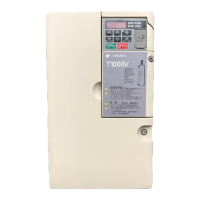
